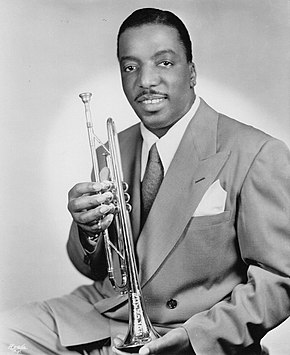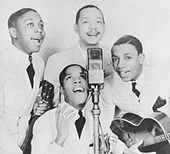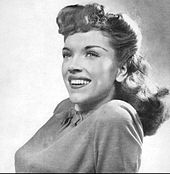List of Harlem Hit Parade number ones of 1943

In 1943,
Most of 1943's number ones were in the jazz and swing genres, which were among the most popular styles of music in the early 1940s.[3] The year's longest-running chart-topper was "Don't Cry Baby" by Erskine Hawkins and his Orchestra, which spent a total of 14 non-consecutive weeks atop the chart between August and December. Two acts each achieved the feat of topping the chart with three different songs. Lucky Millinder and his Orchestra topped the listing with "When the Lights Go On Again", "Apollo Jump" and "Sweet Slumber", which was the final number one of 1943. Duke Ellington and his Famous Orchestra reached the top spot with "Don't Get Around Much Anymore", "A Slip of the Lip (Can Sink a Ship)" and "Sentimental Lady". The latter two songs were the two sides of the same record, but Billboard listed each in the number-one position for one week.[4] Ellington's recording of "Don't Get Around Much Anymore" was one of two versions of the song to top the chart during 1943; the Ink Spots also reached number one with a vocal version of the track. Ellington had originally composed and recorded the track in 1940 as an instrumental with the title "Never No Lament", but it was re-titled and re-released after other artists recorded a vocal version with lyrics written by Bob Russell.[4][5]
Chart history




Notes
a. ^ Jordan's first 16 number ones occurred at a time when Billboard published only one R&B chart. His final two number ones occurred during a period when the magazine published two charts and each topped both listings, but the figure of 113 weeks at number one does not double-count weeks when he topped both.
References
- ^ Goldfarb, Michael (February 1, 2011). "Who 'owns' Harlem, the capital of black America?". BBC. Retrieved September 5, 2020.
- ISBN 978-0-89820-115-4.
- ^ "Swing Music Genre Overview". AllMusic. Retrieved September 4, 2020.
- ^ ISBN 978-0-89820-068-3.
- ISBN 978-0-415-97246-8.
- ISBN 978-0-89820-160-4.
- ISBN 978-0-89820-160-4.
- ^ Dahl, Bill. "Louis Jordan Biography & History". AllMusic. Retrieved December 11, 2021.
- ^ Ruhlmann, William. "Nat King Cole Biography & History". AllMusic. Retrieved September 10, 2020.
- ^ "Best-selling single". Guinness World Records. Retrieved September 5, 2020.
- ^ "The Billboard Music Popularity Chart". Billboard. December 26, 1942. p. 24. Retrieved September 5, 2020.
- ^ a b "The Billboard Music Popularity Chart". Billboard. March 6, 1943. p. 24. Retrieved September 11, 2020.
- ^ a b "The Billboard Music Popularity Chart". Billboard. July 24, 1943. p. 16. Retrieved September 11, 2020.
- ISBN 978-1-58465-443-8.
- Washington Post. Retrieved September 11, 2020.
- ^ "The Billboard Music Popularity Chart". Billboard. January 2, 1943. p. 30. Retrieved September 12, 2020.
- ^ "The Billboard Music Popularity Chart". Billboard. January 9, 1943. p. 38. Retrieved September 12, 2020.
- ^ "The Billboard Music Popularity Chart". Billboard. January 16, 1943. p. 24. Retrieved September 12, 2020.
- ^ "The Billboard Music Popularity Chart". Billboard. January 23, 1943. p. 24. Retrieved September 14, 2020.
- ^ "The Billboard Music Popularity Chart". Billboard. January 30, 1943. p. 24. Retrieved September 14, 2020.
- ^ "The Billboard Music Popularity Chart". Billboard. February 6, 1943. p. 24. Retrieved September 14, 2020.
- ^ "The Billboard Music Popularity Chart". Billboard. February 13, 1943. p. 24. Retrieved September 14, 2020.
- ^ "The Billboard Music Popularity Chart". Billboard. February 20, 1943. p. 24. Retrieved September 14, 2020.
- ^ "The Billboard Music Popularity Chart". Billboard. February 27, 1943. p. 24. Retrieved September 14, 2020.
- ^ "The Billboard Music Popularity Chart". Billboard. March 13, 1943. p. 24. Retrieved September 14, 2020.
- ^ "The Billboard Music Popularity Chart". Billboard. March 13, 1943. p. 24. Retrieved September 15, 2020.
- ^ "The Billboard Music Popularity Chart". Billboard. March 27, 1943. p. 24. Retrieved September 15, 2020.
- ^ "The Billboard Music Popularity Chart". Billboard. April 3, 1943. p. 22. Retrieved September 15, 2020.
- ^ "The Billboard Music Popularity Chart". Billboard. April 10, 1943. p. 23. Retrieved September 15, 2020.
- ^ "The Billboard Music Popularity Chart". Billboard. April 17, 1943. p. 22. Retrieved September 15, 2020.
- ^ "The Billboard Music Popularity Chart". Billboard. April 24, 1943. p. 22. Retrieved September 15, 2020.
- ^ "The Billboard Music Popularity Chart". Billboard. May 1, 1943. p. 22. Retrieved September 15, 2020.
- ^ "The Billboard Music Popularity Chart". Billboard. May 8, 1943. p. 22. Retrieved September 15, 2020.
- ^ "The Billboard Music Popularity Chart". Billboard. May 15, 1943. p. 22. Retrieved September 15, 2020.
- ^ "The Billboard Music Popularity Chart". Billboard. May 22, 1943. p. 22. Retrieved September 15, 2020.
- ^ "The Billboard Music Popularity Chart". Billboard. May 29, 1943. p. 26. Retrieved September 15, 2020.
- ^ "The Billboard Music Popularity Chart". Billboard. June 5, 1943. p. 22. Retrieved September 15, 2020.
- ^ "The Billboard Music Popularity Chart". Billboard. June 12, 1943. p. 22. Retrieved September 15, 2020.
- ^ "The Billboard Music Popularity Chart". Billboard. June 19, 1943. p. 22. Retrieved September 15, 2020.
- ^ "The Billboard Music Popularity Chart". Billboard. June 26, 1943. p. 22. Retrieved September 15, 2020.
- ^ "The Billboard Music Popularity Chart". Billboard. July 3, 1943. p. 24. Retrieved September 15, 2020.
- ^ "The Billboard Music Popularity Chart". Billboard. July 10, 1943. p. 24. Retrieved September 15, 2020.
- ^ "The Billboard Music Popularity Chart". Billboard. July 17, 1943. p. 24. Retrieved September 15, 2020.
- ^ "The Billboard Music Popularity Chart". Billboard. July 31, 1943. p. 18. Retrieved September 11, 2020.
- ^ "The Billboard Music Popularity Chart". Billboard. August 7, 1943. p. 14. Retrieved September 16, 2020.
- ^ "The Billboard Music Popularity Chart". Billboard. August 14, 1943. p. 14. Retrieved September 16, 2020.
- ^ "The Billboard Music Popularity Chart". Billboard. August 21, 1943. p. 14. Retrieved September 19, 2020.
- ^ "The Billboard Music Popularity Chart". Billboard. August 28, 1943. p. 14. Retrieved September 19, 2020.
- ^ "The Billboard Music Popularity Chart". Billboard. September 4, 1943. p. 13. Retrieved September 19, 2020.
- ^ "The Billboard Music Popularity Chart". Billboard. September 11, 1943. p. 12. Retrieved September 19, 2020.
- ^ "The Billboard Music Popularity Chart". Billboard. September 18, 1943. p. 14. Retrieved September 19, 2020.
- ^ "The Billboard Music Popularity Chart". Billboard. September 25, 1943. p. 12. Retrieved September 19, 2020.
- ^ "The Billboard Music Popularity Chart". Billboard. October 2, 1943. p. 14. Retrieved September 19, 2020.
- ^ "The Billboard Music Popularity Chart". Billboard. October 9, 1943. p. 14. Retrieved September 19, 2020.
- ^ "The Billboard Music Popularity Chart". Billboard. October 16, 1943. p. 14. Retrieved September 19, 2020.
- ^ "The Billboard Music Popularity Chart". Billboard. October 23, 1943. p. 12. Retrieved September 19, 2020.
- ^ "The Billboard Music Popularity Chart". Billboard. October 30, 1943. p. 12. Retrieved September 19, 2020.
- ^ "The Billboard Music Popularity Chart". Billboard. November 6, 1943. p. 13. Retrieved September 19, 2020.
- ^ "The Billboard Music Popularity Chart". Billboard. November 13, 1943. p. 14. Retrieved September 19, 2020.
- ^ "The Billboard Music Popularity Chart". Billboard. November 20, 1943. p. 13. Retrieved September 19, 2020.
- ^ "The Billboard Music Popularity Chart". Billboard. November 27, 1943. p. 12. Retrieved September 19, 2020.
- ^ "The Billboard Music Popularity Chart". Billboard. December 4, 1943. p. 12. Retrieved September 19, 2020.
- ^ "The Billboard Music Popularity Chart". Billboard. December 11, 1943. p. 12. Retrieved September 17, 2020.
- ^ "The Billboard Music Popularity Chart". Billboard. December 18, 1943. p. 12. Retrieved September 17, 2020.
- ^ "The Billboard Music Popularity Chart". Billboard. December 25, 1943. p. 33. Retrieved September 17, 2020.
